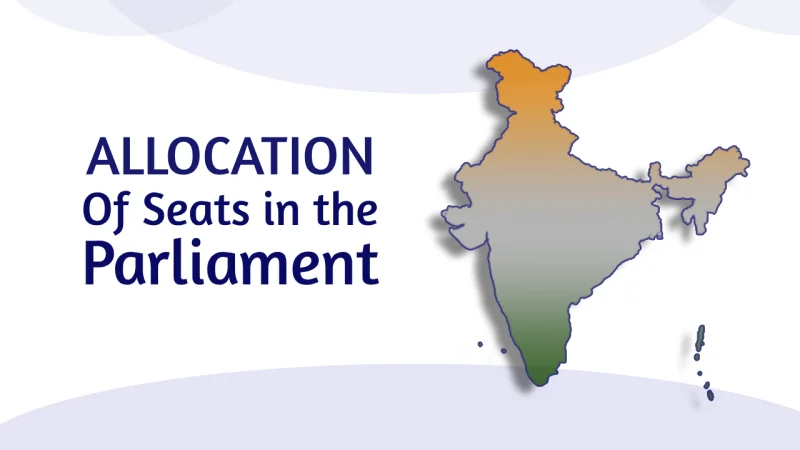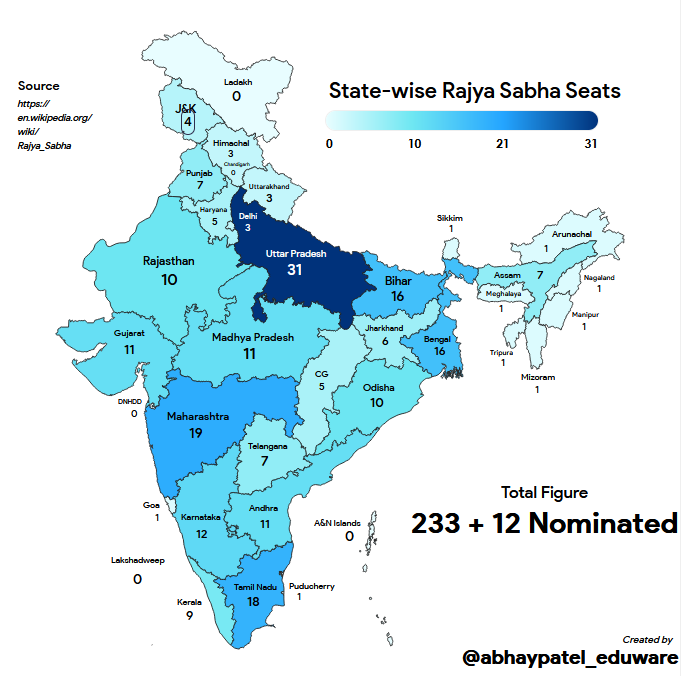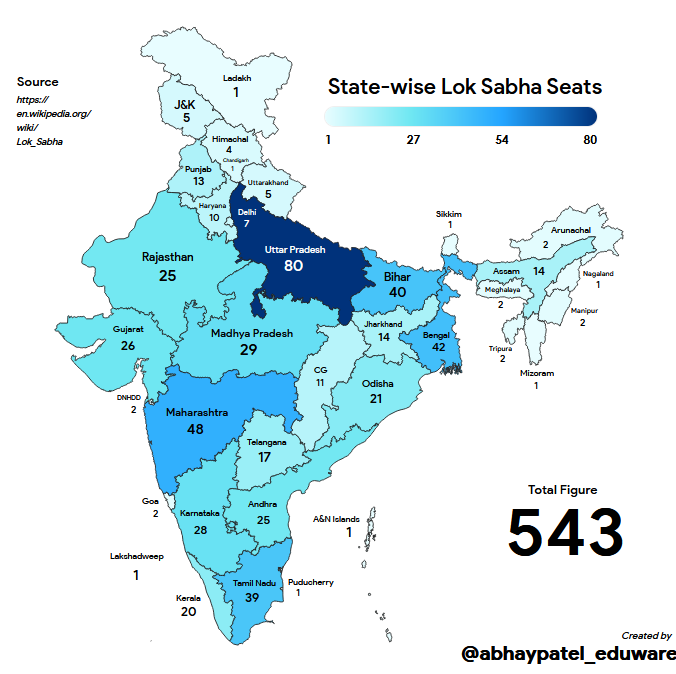
Allocation of Seats in Parliament of India | State-wise Parliamentary Seats
Introduction
The constitution of India provides a parliamentary system of governance, both at the centre and in the states. Article 79 of the Indian Constitution establishes a Parliament for the Union, which consists of the President and two Houses: the Lok Sabha (House of the People) and the Rajya Sabha (Council of States). The allocation of seats in these Houses is determined by delimitation commissions according to Article 82, which are appointed by the President of India.
Rajya Sabha (Article 80)
The Rajya Sabha is the upper house of the Parliament of India, representing the states and union territories.
- The total membership of the Rajya Sabha is 245, out of which 233 members are elected by the legislatures of the states and union territories.
- Twelve (12) members are nominated by the President of India for their expertise in various fields such as literature, science, art, and social service.
- It is a permanent body and is not subject to dissolution, but one-third of its members retire every two years.
- Representation of People Act 1951 provided the term of office for Rajya Sabha members as six years.
- There are no seats reserved for Scheduled Castes (SC) and Scheduled Tribes (ST) in the Rajya Sabha.
Allocation of Seats in Rajya Sabha
The allocation of seats in the Rajya Sabha is based on the population of each state and union territory, as per the latest census. The following table shows the number of seats allocated to each state and union territory in the Rajya Sabha:
| State/Union Territory | Number of Seats |
|---|---|
| Andhra Pradesh | 11 |
| Arunachal Pradesh | 1 |
| Assam | 7 |
| Bihar | 16 |
| Chhattisgarh | 5 |
| Delhi | 3 |
| Goa | 1 |
| Gujarat | 11 |
| Haryana | 5 |
| Himachal Pradesh | 3 |
| Jammu and Kashmir | 4 |
| Jharkhand | 6 |
| Karnataka | 12 |
| Kerala | 9 |
| Madhya Pradesh | 11 |
| Maharashtra | 19 |
| Manipur | 1 |
| Meghalaya | 1 |
| Mizoram | 1 |
| Nagaland | 1 |
| Odisha | 10 |
| Punjab | 7 |
| Puducherry | 1 |
| Rajasthan | 10 |
| Sikkim | 1 |
| Tamil Nadu | 18 |
| Telangana | 7 |
| Tripura | 1 |
| Uttar Pradesh | 31 |
| Uttarakhand | 3 |
| West Bengal | 16 |
| Total | 233 |

The Lok Sabha can be Extended during the National Emergency by the law of Parliament for One year at a time for any length of time.
But this extension cannot go beyond a period of 6 months after the Emergency has ceased.
Lok Sabha (Article 81)
The Lok Sabha is the lower house of the Parliament of India, representing the people of India.
- The Lok Sabha consists of a maximum of 550 members, out of which 530 members are elected by the people of the states, 20 members are elected by the people of the Union territories,
- Previously, 2 members were nominated by the President of India from the Anglo-Indian community but this provision has been abolished by the 104th Constitutional Amendment Act, 2019.
- The Lok Sabha is dissolved every five years, and elections are held to elect new members.
- The term of office for Lok Sabha members is five years.
- The Lok Sabha has the power to make laws on any subject in the Union List and Concurrent List, as well as on certain subjects in the State List.
Allocation of Seats in Lok Sabha
The allocation of seats in the Lok Sabha is also based on the population of each state and union territory, as per the latest census. The following table shows the number of seats allocated to each state and union territory in the Lok Sabha:
| State/Union Territory | Number of Seats |
|---|---|
| Andhra Pradesh | 25 |
| Arunachal Pradesh | 2 |
| Assam | 14 |
| Bihar | 40 |
| Chandigarh | 1 |
| Chhattisgarh | 11 |
| Dadra and Nagar Haveli and Daman and Diu | 2 |
| Delhi | 7 |
| Goa | 2 |
| Gujarat | 26 |
| Haryana | 10 |
| Himachal Pradesh | 4 |
| Jammu and Kashmir | 5 |
| Jharkhand | 14 |
| Karnataka | 28 |
| Kerala | 20 |
| Ladakh | 1 |
| Lakshadweep | 1 |
| Madhya Pradesh | 29 |
| Maharashtra | 48 |
| Manipur | 2 |
| Meghalaya | 2 |
| Mizoram | 1 |
| Nagaland | 1 |
| Odisha | 21 |
| Puducherry | 1 |
| Punjab | 13 |
| Rajasthan | 25 |
| Sikkim | 1 |
| Tamil Nadu | 39 |
| Telangana | 17 |
| Tripura | 2 |
| Uttar Pradesh | 80 |
| Uttarakhand | 5 |
| West Bengal | 42 |
| Total | 543 |

The Lok Sabha can be Dissolved by the President of India on the advice of the Prime Minister.
The Lok Sabha can also be dissolved if a no-confidence motion is passed against the government.
Frequently Asked Questions (FAQs) on Allocation of Seats in Parliament of India
1. What is the total number of seats in the Lok Sabha and Rajya Sabha?
The Lok Sabha has a maximum of 550 seats, while the Rajya Sabha has a total of 250 seats.
2. How are the members of the Rajya Sabha elected?
Members of the Rajya Sabha are elected by the elected members of the State Legislative Assemblies and the Union territories using a single transferable vote system of proportional representation.
3. What is the term of office for members of the Lok Sabha and Rajya Sabha?
Members of the Lok Sabha serve a term of five years, while members of the Rajya Sabha serve a term of six years. However, one-third of the Rajya Sabha members retire every two years.
4. How are the seats in the Lok Sabha and Rajya Sabha allocated to different states and union territories?
The allocation of seats in both the Lok Sabha and Rajya Sabha is based on the population of each state and union territory, as per the latest census. The President of India appoints a delimitation commission to determine the allocation of seats.
5. Are there any reserved seats for Scheduled Castes and Scheduled Tribes in the Lok Sabha and Rajya Sabha?
Yes, there are reserved seats for Scheduled Castes (SC) and Scheduled Tribes (ST) in the Lok Sabha and Rajya Sabha. The number of reserved seats is determined by the President of India based on the population of SCs and STs in each state and union territory.
Abhay Raj Patel
Student at Lucknow University (since 2023)
Passionate about competitive exam preparation
Committed to sharing only verified and accurate information.